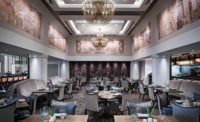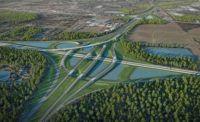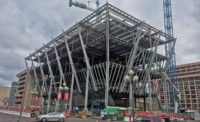Design firms across the South are coming off another strong year and were able to ride that momentum into 2020. But as firms adjust to a new normal in the face of the COVID-19 pandemic, uncertainty lies ahead in terms of what the market will look like six months from now and beyond.
The top 100 companies on the ENR Texas & Louisiana Top Design Firms list reported $7.92 billion in regional revenue in 2019, compared with the $7.3 billion reported by the top 100 firms last year. ENR Texas & Louisiana’s regional coverage area also includes revenue from work in Arkansas, Mississippi and Oklahoma.
According to the American Institute of Architects, the Architecture Billings Index in the South fell sharply over the last year. The region’s score was 44.2 in March 2020, a 10-point drop from the same time last year, when the score was 54.2. A score below 50 indicates a decrease in billings. As recently as January and February of 2020, the South led the nation with scores of 56.7 and 58, respectively.
“While the ABI was strong at the beginning of the year, it has certainly taken a hit with the onset of coronavirus and fell by 20 points last month,” says Kathleen Gordon, executive director of AIA Louisiana. “With architecture and construction being considered essential through all of this, many firms are still working, even through what has admittedly been a slowdown of about 20% in Louisiana. While we all face many challenges ahead, we can remain optimistic about opportunities that will come as reopenings begin.”
Even as the COVID-19 crisis put the nation on lockdown, designers remained busy, and many had booked enough work to carry them through the summer, says Mattia Flabiano III, senior principal at Page Southerland Page Inc., Dallas, and president-elect of the Architecture and Design Foundation for AIA Dallas.
“I was on an AIA panel discussion with four other firms. All of them were very bullish on this first half of the year. But I think a lot ... are concerned about the third and fourth quarters,” he says.
|
Related Link |
Critical Infrastructure Needs
The past year brought sizable gains for many design companies. Burns & McDonnell saw dramatic growth across the region, including at its locations in Houston, Fort Worth, Dallas, Austin and Oklahoma City. The Kansas City, Mo.-based firm led this year’s Top Design Firms list with $850.4 million in revenue, a 51% increase over $563.7 million last year.
Critical infrastructure has been a major sector for the firm, which is working on nearly 13,000 projects of this type nationwide. In one of its ongoing projects, the firm is working with an undisclosed client to provide environmental, design and construction services for a new transmission line in Texas.
“We’ll continue to have a need for reliable power, water and other basic services. These critical infrastructure projects will continue to proceed,” says Leslie Duke, president and general manager for the firm’s locations in Houston, Austin and Oklahoma City.
Louisiana was the site of one of Burns & McDonnell’s most noteworthy recent projects, the $65-million Terrebonne to Bayou Vista Transmission Upgrade. The project involved upgrading a critical, 24-mile section of the Entergy-Louisiana transmission grid in south-central Louisiana. The firm completed the project in May 2018.
Farther north in Louisiana, Ruston-based Hunt, Guillot & Associates experienced an active year across market sectors, with $38 million in regional revenue. “Throughout the year, we saw ongoing strength in the economy and a trend of steady growth,” says Trotter Hunt, HGA’s vice president of engineering.
Although regional revenue was down from $46.3 million in 2018, HGA has been busy with projects on several fronts. The firm was recently awarded a contract to work with Gulf Coast Ammonia on its 1.3-million-ton-per-year anhydrous ammonia plant in Texas City. HGA also continues to design natural gas compressor stations for several large pipeline transmission companies and is helping engineer and construct a new feed mill in Simsboro, La., for poultry producer House of Raeford Farms.
Meanwhile, both public and commercial projects fed the Arkansas market in 2019, and the commercial trend has continued into 2020, with Costco Wholesale and Amazon announcing plans to build in Little Rock. “The market’s been fairly strong,” says Brent Stevenson, executive director of AIA Arkansas.
Texas Firms Dominate Region
Robust growth continued for another year in Texas, with firms in the state accounting for more than half of the spots on this year’s Top Design Firms ranking. “The Texas region was extremely strong. The economy was one of the best in the country, or even the world,” Flabiano says.
Flabiano describes 2019 as one of the better years for his firm, Page Southerland Page, which saw revenues climb to $134.3 million, a 22% increase. The firm showed gains in nearly every market sector, including energy, tech, higher education, hospitality and housing as more people continued to move to Texas.
“We’ll continue to have a need for reliable power, water and other basic services. These critical infrastructure projects will continue to proceed.”
– Leslie Duke, President and General Manager in Houston, Austin and Oklahoma City, Burns & McDonnell
Halff Associates Inc. of Richardson, Texas, reported growth in revenue and in the size of its workforce. Halff saw a 23% rise in its number of employees after purchasing Florida-based Genesis and Genesis CEI, expanding the firm’s footprint into the Southeast and adding 100 employees. The firm reported $153.5 million in regional revenue, a 14% increase over last year.
One of Halff’s major projects is the $320-million Mill Creek/Peaks Branch/State-Thomas Drainage Relief Tunnel in the city of Dallas. The five-mile tunnel, consisting of two miles of 35-ft-dia pipe and three miles of 30-ft-dia pipe, is the largest tunnel under construction in the U.S. and will provide 100-year flood protection for nearly 2,200 commercial and residential properties in the east Dallas area. The firm is also providing analysis and environmental assessment for a $160-million project to improve 41 miles of U.S. 82 for the Texas Dept. of Transportation’s Paris District.
Education is a key sector in Texas and contributed to gains for Fort Worth-based Huckabee, which saw revenue reach $83.9 million in 2019, compared with $82.5 million the previous year. “Early education was a space of significant growth for our firm in 2019; it also became a priority for Texas public school districts following new mandates for prekindergarten during the most recent state legislative session,” says CEO Chris Huckabee, referencing a push by Texas lawmakers to offer all-day preschool programs.
Huckabee worked with Mansfield Independent School District to design the Dr. Sarah Jandruko Academy for Early Learners. The firm also completed the 563,000-sq-ft C.E. King High School campus for Sheldon ISD and the 12,000-seat Children’s Health Stadium for Prosper ISD.
Being in a smaller market, Oklahoma firms have to work harder to stay competitive with neighboring markets like Dallas. “Our projects aren’t as large, so we have to do more of them to keep up with the rest of the world,” says Mark Gandy, AIA Oklahoma president.
Schools, higher education and churches have been strong areas for Oklahoma design firms. The state also has seen its share of public projects, including the $465-million Gathering Place, a 66.5-acre city park in Tulsa. Oklahoma City is building a $288-million convention center and the $132-million, 70-acre Scissortail Park. Those projects, in turn, have spurred nearby downtown commercial developments.
A Post-Pandemic Market
As firms continue to ride the wave of the past year’s successes, they remain wary of what the COVID-19 crisis could mean for future billings. “There hasn’t been a big drop-off yet in our work. Most of the firms have stayed busy and had people working from home,” Gandy says.
But firms aren’t naïve as to what the future could hold. In Oklahoma, for example, a decline in the oil and gas royalties that usually build up the state’s budget could affect funding for projects like schools. “What we’re concerned about is what might happen in six months,” Gandy says.
The situation has been a mixed bag for Arkansas firms, Stevenson says. “There are some jobs that were halted and some that are still going, depending on what was in the queue,” he says.
Scott Clark, vice president and general manager for Burns & McDonnell in Dallas and Fort Worth, says some markets have halted or slowed down, while others are growing. Critical infrastructure projects could see increased demand following the federal government’s decision to lower interest rates as an emergency response to COVID-19. “We may see the low rates open doors to advancing infrastructure projects, such as water, wastewater, roads, bridges and other critical projects for municipalities that choose to take advantage,” Clark says.
Technology has provided a lifeline for firms throughout the COVID-19 crisis. Huckabee’s prior investment in virtual desktops, BIM 360 and other cloud-based technology and communication tools has paid off as employees continue to work remotely. “Firms that have made these investments are thriving; those who have not are struggling,” says CEO Chris Huckabee.
Despite the current crisis, Trotter Hunt believes there are still opportunities ahead, and he remains confident that firms in Louisiana and Texas, as well as throughout the U.S., are positioned to perform well in the long term. “Engineering and construction firms need to support their clients through this challenging period by coming up with innovative solutions to keep projects on track and costs at a minimum,” he says.









Post a comment to this article
Report Abusive Comment